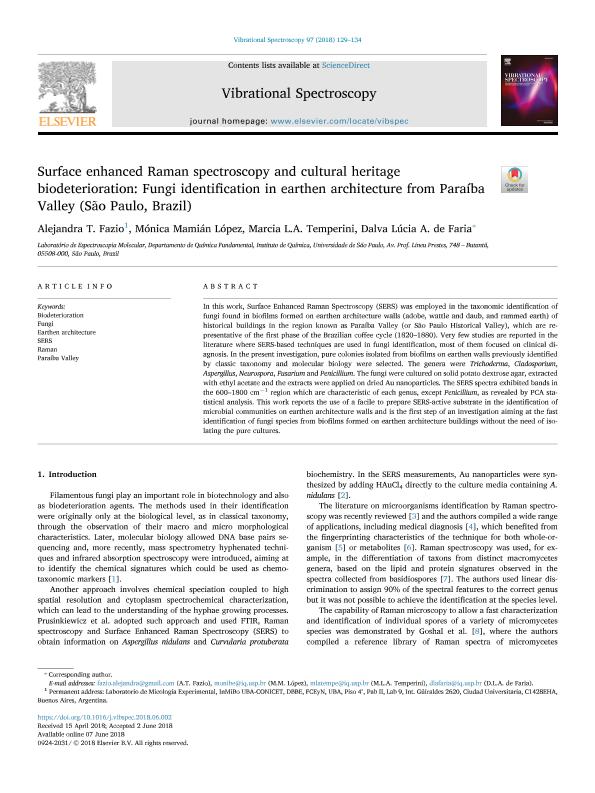Mostrar el registro sencillo del ítem
dc.contributor.author
Fazio, Alejandra Teresa

dc.contributor.author
López, Mónica Mamián
dc.contributor.author
Temperini, Marcia L.A.
dc.contributor.author
de Faria, Dalva Lúcia A.
dc.date.available
2019-10-10T18:35:14Z
dc.date.issued
2018-07
dc.identifier.citation
Fazio, Alejandra Teresa; López, Mónica Mamián; Temperini, Marcia L.A.; de Faria, Dalva Lúcia A.; Surface enhanced Raman spectroscopy and cultural heritage biodeterioration: Fungi identification in earthen architecture from Paraíba Valley (São Paulo, Brazil); Elsevier Science; Vibrational Spectroscopy; 97; 7-2018; 129-134
dc.identifier.issn
0924-2031
dc.identifier.uri
http://hdl.handle.net/11336/85567
dc.description.abstract
In this work, Surface Enhanced Raman Spectroscopy (SERS) was employed in the taxonomic identification of fungi found in biofilms formed on earthen architecture walls (adobe, wattle and daub, and rammed earth) of historical buildings in the region known as Paraíba Valley (or São Paulo Historical Valley), which are representative of the first phase of the Brazilian coffee cycle (1820–1880). Very few studies are reported in the literature where SERS-based techniques are used in fungi identification, most of them focused on clinical diagnosis. In the present investigation, pure colonies isolated from biofilms on earthen walls previously identified by classic taxonomy and molecular biology were selected. The genera were Trichoderma, Cladosporium, Aspergillus, Neurospora, Fusarium and Penicillium. The fungi were cultured on solid potato dextrose agar, extracted with ethyl acetate and the extracts were applied on dried Au nanoparticles. The SERS spectra exhibited bands in the 600–1800 cm−1 region which are characteristic of each genus, except Penicillium, as revealed by PCA statistical analysis. This work reports the use of a facile to prepare SERS-active substrate in the identification of microbial communities on earthen architecture walls and is the first step of an investigation aiming at the fast identification of fungi species from biofilms formed on earthen architecture buildings without the need of isolating the pure cultures.
dc.format
application/pdf
dc.language.iso
eng
dc.publisher
Elsevier Science

dc.rights
info:eu-repo/semantics/openAccess
dc.rights.uri
https://creativecommons.org/licenses/by-nc-sa/2.5/ar/
dc.subject
BIODETERIORATION
dc.subject
EARTHEN ARCHITECTURE
dc.subject
FUNGI
dc.subject
PARAÍBA VALLEY
dc.subject
RAMAN
dc.subject
SERS
dc.subject.classification
Química Orgánica

dc.subject.classification
Ciencias Químicas

dc.subject.classification
CIENCIAS NATURALES Y EXACTAS

dc.title
Surface enhanced Raman spectroscopy and cultural heritage biodeterioration: Fungi identification in earthen architecture from Paraíba Valley (São Paulo, Brazil)
dc.type
info:eu-repo/semantics/article
dc.type
info:ar-repo/semantics/artículo
dc.type
info:eu-repo/semantics/publishedVersion
dc.date.updated
2019-07-24T18:35:21Z
dc.journal.volume
97
dc.journal.pagination
129-134
dc.journal.pais
Países Bajos

dc.journal.ciudad
Amsterdam
dc.description.fil
Fil: Fazio, Alejandra Teresa. Consejo Nacional de Investigaciones Científicas y Técnicas. Oficina de Coordinación Administrativa Ciudad Universitaria. Instituto de Micología y Botánica. Universidad de Buenos Aires. Facultad de Ciencias Exactas y Naturales. Instituto de Micología y Botánica; Argentina. Universidad de Buenos Aires. Facultad de Ciencias Exactas y Naturales. Departamento de Biodiversidad y Biología Experimental. Laboratorio de Micología Experimental; Argentina
dc.description.fil
Fil: López, Mónica Mamián. Universidade de Sao Paulo; Brasil
dc.description.fil
Fil: Temperini, Marcia L.A.. Universidade de Sao Paulo; Brasil
dc.description.fil
Fil: de Faria, Dalva Lúcia A.. Universidade de Sao Paulo; Brasil
dc.journal.title
Vibrational Spectroscopy

dc.relation.alternativeid
info:eu-repo/semantics/altIdentifier/doi/https://doi.org/10.1016/j.vibspec.2018.06.002
dc.relation.alternativeid
info:eu-repo/semantics/altIdentifier/url/https://www.sciencedirect.com/science/article/pii/S0924203118301346
Archivos asociados
